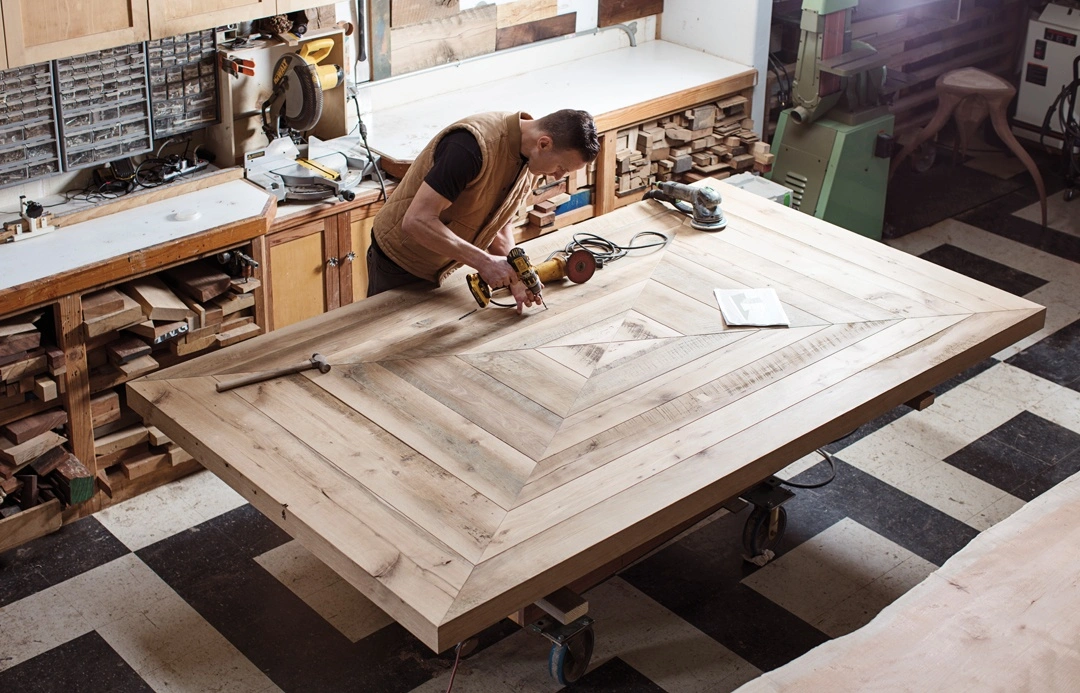Walk into any hardware store, grab a board labeled “4×4,” and you’d expect it to measure exactly four inches by four inches. But it doesn’t! That “4×4” post actually measures just 3.5 inches on each side. And it’s not a mistake. It’s just how lumber sizing works in most of the U.S. and Canada. The U.S. Department of Agriculture’s Wood Handbook statement clarifies it. Officials say that standard dimensional lumber is usually about ¾ inch smaller than its nominal size.
That missing half inch is not a minor detail. It adds up fast when you’re framing a house, building a deck, or trying to squeeze a board into a cabinet slot. This blog will highlight what are the actual dimensions of a 4×4 post. Besides, it shows you exactly what you’re buying, and explains why accurate measurements matter more than ever, especially when precision means avoiding expensive do-overs.
These Are the Real Dimensions of a 4×4 Post (and Why They’re Smaller Than You Think)
Forget the four-inch square post you imagine when you see a 4×4 label. In reality, modern retail lumber gives you closer to 3.5 inches by 3.5 inches on most effective surfaces. This matters when that half-inch disappears on every side, especially if you’re aligning posts for pergolas, fences, or deck railings.
Why a Nominal 4×4 Isn’t Actually Four Inches
Nominal sizing comes from the old practice of naming boards based on their rough, uncut dimensions before drying or planning. After lumber is kiln-dried and planed smooth, roughly half an inch gets removed from both thickness and width.
That’s why a green 4×4 becomes a dressed 3.5×3.5 finished post. According to long-standing building standards, these are the minimum dimensions of surfaced, four-sided softwood lumber, and they’re consistent across most North American suppliers.
What Actual Dimensions Retailers List
A quick visit to any hardware store confirms it. Most 4×4 posts are sold with actual dimensions clearly printed on the tag or fine print. They almost always read 3.5 inches by 3.5 inches. However, some products may show slight variances, such as 3.56 inches.
This variation depends on how the post was milled or surfaced. The more you go up in size, the more the difference grows. However, the shrinkage pattern will remain roughly the same.
How That Difference Affects Your Project
When posts that are supposed to fit tightly together end up being smaller than expected, your entire layout can drift. Even if you select the best wood for woodworking, that small gap of half an inch can cause some serious damage to the overall project timeline.
If your design relies on tight tolerances, a missing chunk like that can ruin symmetry. It can even leave you improvising on-site with spacers or additional bracing. Knowing the actual dimensions ahead of time keeps everything smooth.
How to Deal with Those Sizing Gaps Like a Pro
One solid way to prevent surprises is always to assume dimensional lumber is about ¾ inch smaller than labeled. An even better way is to measure everything yourself. A quick check with a tape measure or caliper takes less than ten seconds. It saves hours of frustration later. If you’re working with pre-cut joinery, plug in the actual post dimensions when you do your layout, not the nominal ones.
Quick Summary Table of Nominal and Actual Sizes
| Nominal Size | Actual Dimensions (inches) |
| 4×4 | 3.5 × 3.5 |
| 4×6 | 3.5 × 5.5 |
| 4×8 | 3.5 × 7.25 |
| 4×10 | 3.5 × 9.25 |
| 4×12 | 3.5 × 11.25 |
Even wider timbers, like nominal 6×6 or 8×8, are also reduced, often by around ¾ to a full inch on each side. This isn’t a labeling error or store trick. On the contrary, it’s simply how lumber is milled and standardized across the board.
The Whole Actual vs Nominal Size Thing Is Not Just a Technicality
You might think the difference between nominal and actual lumber sizes is just a harmless labeling thing. However, it’s more than that. It affects measurements, spacing, design, material estimates, and how well things actually fit together. What seems like a small difference can cause real construction or woodworking problems.
Nominal sizes are essentially legacy names. The 4×4 post, for example, once truly measured 4 inches across when it was rough-cut and freshly sawn. But as drying and surfacing became standard, wood started shrinking down, yet the names stuck. Most lumber now loses about ½ to ¾ inch in each dimension before it ever hits the store shelf.
Here’s why that’s a big deal beyond just the math:
- Blueprints are based on nominal sizes, so using actual dimensions without adjusting can throw off framing plans.
- Framing calculators rely on nominal inputs for board footage and spacing estimates.
- Furniture builds can be mismatched with the wrong assumption.
- Species like pine or fir shrink more than others. So, the final size varies slightly according to the wood type.
- Even engineered lumber sticks to nominal terms. So, all LVL beams and PSL headers still follow the same naming rules.
- Woodworkers and contractors often learn the hard way when pre-cuts don’t align.
Here’s What a 2×6 Really Measures After It Leaves the Mill
When you buy a 2×6, you’re not actually getting two inches by six inches. The finished board is closer to 1½ inches thick by 5½ inches wide. This is due to drying and planning procedures, and it is standard across softwood framing lumber.
Nominal 2×6 boards begin as rough-sawn logs that meet the 2-by name early in the process. However, lumber is kiln-dried. Later on, it is surfaced smooth on all four sides, which trims away about ½ inch in both thickness and width. The small shrinkage makes a big difference. It can impact when framing walls or building joists to exact spacing.
Using correct values in your takeoffs, material lists, or framing calculators is essential. If you assume a 2×6 actual size is six inches wide, you’ll overestimate material by a noticeable margin or misalign studs and supports. Here’s a handy conversion chart:
| Nominal Size | Actual Size (inches) |
| 2×4 | 1½ × 3½ |
| 2×6 | 1½ × 5½ |
| 2×8 | 1½ × 7¼ |
| 2×10 | 1½ × 9¼ |
| 2×12 | 1½ × 11¼ |
Some suppliers may list slightly larger figures depending on finish grade or milling depth. But 1½ × 5½ is the widely accepted standard for construction-grade softwood lumber.
In practical terms, you’ll want to design rough openings, floor joisting, or wall framing count with that 5½-inch width, not the full six. That little difference keeps material lists accurate, prevents forced fits, and avoids wasted time or wood.
A 1×12 Sounds Huge, but It’s Actually Not What You Think
If someone hands you a 1×12 board, you might picture a full one-inch-thick slab. But that’s not the case! In reality, the 1×12 lumber actual size measures only ¾ inch thick. At the same time, its width is around 11¼ inches. That’s because nominal labels refer to rough-cut stock. They are not the actual dimensions of the final surfaced product.
Here’s how it works:
Manufacturers cut rough boards at 1 inch by 12 inches. Then, the drying process starts. After drying, they are planed smooth and the thickness drops to ¾ inch. The width also shrinks to around 11¼ inches.
Most large-format hardware retailers and lumber yards list the actual 1×12 size as 0.75″ × 11.25″. That’s the size you’ll actually receive. So, don’t budget or cut bench tops expecting a full inch.
Here’s a summary chart showing the most commonly sold 1-inch nominal boards:
| Nominal Size | Actual Size (inches) |
| 1×4 | ¾ × 3½ |
| 1×6 | ¾ × 5½ |
| 1×8 | ¾ × 7¼ |
| 1×10 | ¾ × 9¼ |
| 1×12 | ¾ × 11¼ |
This hasn’t changed much over decades of industry practice. Whether it’s pine, spruce, or fir, softwood boards follow that surfaced standard. If you want thicker or full-dimension lumber, try hardwood mills or specialty suppliers offering 4/4 (one-inch) or custom stock.
This Is How You Accurately Calculate Lumber for Any Frame
When you’re planning a framing job, you need precise estimates of wood for building furniture. If you miscalculate the lumber for the project’s framework, it can lead to sudden delays or budget overruns. That’s why there should be an immaculate plan for calculating all lumber needs of your projects without any error. We can help you in that regard! Here’s a step-by-step process to calculate lumber dimensions and requirements for any frame:
Step 1: Start with Wall Dimensions
Measure or sketch the exact wall length and height. This will include door and window openings. Determine “on center” spacing for studs (commonly 16″ OC), which lets you plan the number of studs and plates efficiently.
Step 2: Translate Nominal Sizes
Use nominal dimensions when you calculate board footage. Even though a 2×4 is really 1½″ × 3½″ after milling, framing plans, price lists, and hardware still assume nominal values.
Step 3: Use the Board Foot Formula for Volume and Cost
Accurate material estimation needs board-foot calculation. Here’s the standard formula:
Board Feet = T (in) × W (in) × L (ft) ÷ 12
If the pieces are measured in inches, use the following formula:
Board Feet = T (in) × W (in) × L (in) ÷ 144
Example:
2×4, that is 10 ft long
(2 × 4 × 10) ÷ 12 = 6.67 board feet per piece
Step 4: Calculate Required Pieces for Framing Elements
You can count studs using this rule:
Number of studs = [ Wall length (in) ÷ Stud spacing (in) ] + 1
Top and bottom plates typically require double layers. So, multiply the wall width by the number of layers and add 5–10% for waste.
Step 5: Create a Material Table with Common Sizes and Board Footage
| Item | Nominal Size | Board Feet per Linear Foot | Example: 10 ft Quantity | Total BF |
| Stud (2×4) | 2×4 | 0.667 bd ft | 8 pieces | 5.33 BF |
| Plate (2×6) | 2×6 | 1.0 bd ft | 4 pieces (20 ft) | 20 BF |
| Header (2×12 + ply) | 2×12 | 2.0 bd ft | 2 pieces (3 ft each) | 12 BF |
These board footage numbers use nominal widths and thicknesses with actual lengths in feet. Stick with nominal values when calculating, since that’s how suppliers list and price lumber.
Step 6: Add 10–15% Extra for Waste or Errors
Always overbuy slightly. That’s because mistakes, bad cuts, or defective boards happen more often than you’d like. Framing isn’t just math, but an actual reality.
Step 7: Use Framing Calculators
Use online calculators or simple spreadsheets to input thickness, width, and length. These tools will give you board-foot totals, estimated cost, and linear footage automatically. Just make sure you’re inputting nominal dimensions.
Here’s a Quick Chart Comparing Nominal and Actual Lumber Sizes
Understanding nominal versus actual lumber sizes isn’t optional. On the contrary, it’s fundamental to avoid waste, misfits, and bad joints. Here’s a table, built around reliable North American standards, showing what you actually get when you buy nominal lumber sizes.
| Nominal Size | Actual Size (Inches) |
| 1×2 | ¾ × 1½ |
| 1×3 | ¾ × 2½ |
| 1×4 | ¾ × 3½ |
| 1×6 | ¾ × 5½ |
| 1×8 | ¾ × 7¼ |
| 1×10 | ¾ × 9¼ |
| 1×12 | ¾ × 11¼ |
| 2×2 | 1½ × 1½ |
| 2×3 | 1½ × 2½ |
| 2×4 | 1½ × 3½ |
| 2×6 | 1½ × 5½ |
| 2×8 | 1½ × 7¼ |
| 2×10 | 1½ × 9¼ |
| 2×12 | 1½ × 11¼ |
| 4×4 | 3½ × 3½ |
| 4×6 | 3½ × 5½ |
| 4×8 | 3½ × 7¼ |
| 4×10 | 3½ × 9¼ |
| 4×12 | 3½ × 11¼ |
| 6×6 | 5½ × 5½ |
| 8×8 | 7½ × 7½ |
Before You Buy Lumber, Use This Simple Rule of Thumb
There’s an easy rule of thumb you can use before buying lumber so you don’t get caught off guard:
- If the nominal thickness is under 1 inch, estimate the actual size as ¼ inch smaller.
- If the nominal size is between 2 and 8 inches, expect it to be ½ inch smaller after milling.
- If the nominal thickness is over 8 inches, plan on it being ¾ inch smaller once surfaced.
These rules are created by assessing the process of dimensional lumber manufacturing. For instance, most softwood posts are not just planed on two but four sides. That means a 2×4 softwood board will measure 1 ½ inches thick and 3 ½ inches wide. The same goes for the rest of the softwood lumber board sizes.
Why These Rules Matter in Real Projects
Following the rules given above can help you increase material estimation accuracy. Besides, it reduces the chances of cost overruns or delays. Here are some more reasons why you should be using these rules in your next projects:
- Predictable shrink margin makes job-site math easy
- Estimation becomes easier without pulling out a measuring tape every time.
- Conversion of nominal sizes becomes seamless. It reduces the need for calculators or ordering materials.
Use Cases Where These Rules Save Time
All of these are not just theoretical shenanigans. On the contrary, we have tested these out in real-time. Here are some of the use cases where the given rules can save the day:
- Rough framing
- Deck boards or joists
- Cabinet or shelving builds
- Timbers and beams
| Note |
| These rules aren’t perfect. Some suppliers may shave more or less depending on the species. However, they’re accurate enough for everyday estimating. So, they’ll save you from having to redo a cut. |
| Nominal Size Range | Rule of Thumb Estimate |
| Under 1″ | Subtract ¼″ |
| 2″ to 8″ | Subtract ½″ |
| Above 8″ | Subtract ¾″ |
Conclusion
You must be surprised to know what are the actual dimensions of a 4×4 post. We already disclosed that several procedures remove some raw material from the post. While the raw-cut lumber was 4×4, its planing and drying reduces it down to 3.5×3.5. That’s not just for 4×4 lumber boards but for all other dimensional posts as well.
Because the dimensions vary, it is necessary to buy slightly more than what you need. That’s how you can eliminate cost overruns. Besides, it helps contractors ensure they have enough material to complete the project in time. We have already streamlined a plan to calculate the true dimensions of your lumber posts for accurate material estimations. However, if you don’t want the hassle at all, contact our team, and we’ll handle all the hard work for you.






